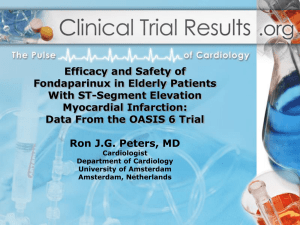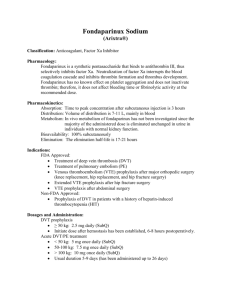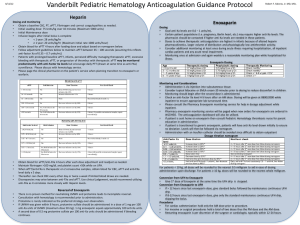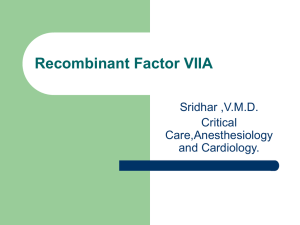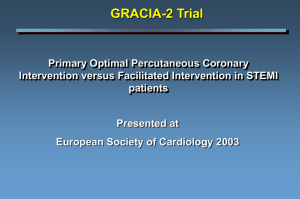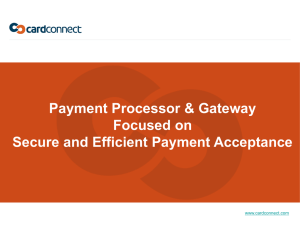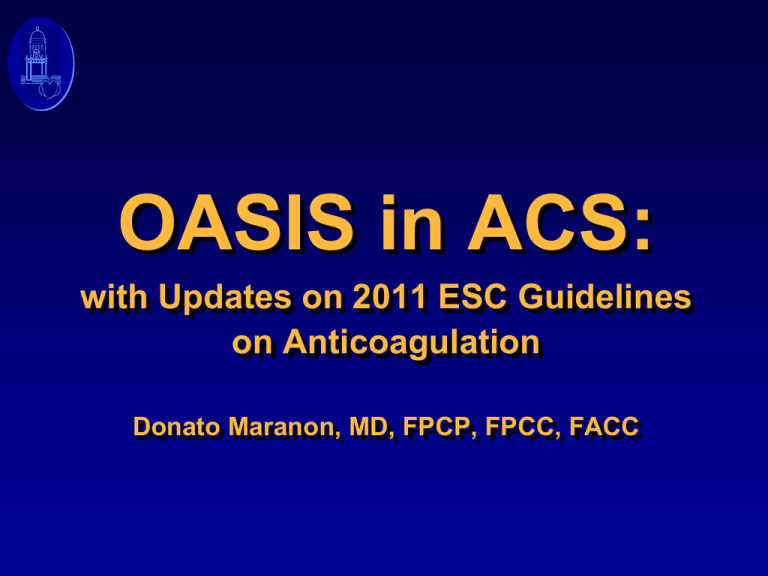
OASIS in ACS:
with Updates on 2011 ESC Guidelines
on Anticoagulation
Donato Maranon, MD, FPCP, FPCC, FACC
Dramatic Improvement of Outcome over
the Last 30 years
Antiplatelet agents
Anticoagulants
Revascularization / Reperfusion / Thrombolysis
Long term treatment / secondary prevention
Implementation of guidelines
Therapeutic Options in Acute Coronary
Syndromes
Anti-ischemic treatment
Antiplatelet agents
Anticoagulants
Revascularization/Reperfusion/Thrombolysis
Long term treatment/secondary prevention
Targets for antithrombotics
Tissue factor
Collagen
Aspirin
Plasma clotting
cascade
Direct Xa inhib
ADP
Thromboxane A2
Prothrombin
Fondaparinux
LMWH
Heparin
AT
AT
Factor
Xa
Conformational
activation of GPIIb/IIIa
GPIIb/IIIa
inhibitors
Thrombin
Platelet aggregation
Bivalirudin
Hirudin
Dabigatran
Clopidogrel
Prasugrel
AZD 6140
Fibrinogen
Fibrin
Thrombus
Net Clinical Benefit of
Anticoagulants
ROADMAP TO UA/NSTEMI
Early Conservative Strategy
•
•
•
•
•
•
Bedrest, O2 if indicated
Nitrates, Morphine, BB, ACEi
Aspirin, Clopidogrel
LMWH or UFH or Fondaparinux
Monitor with serial ECG and cardiac biomarkers
Eptifibatide or Tirofiban, if with continuing ischemia,
elevated TnT or TnI, and other high risk factors
ROADMAP TO UA/NSTEMI
Early Invasive Strategy
•
•
•
•
Bedrest, O2 if needed
Nitrates, Morphine, BB, ACEi
Aspirin, LMWH or UFH
GP IIb/IIIa, tirofiban, eptifibatide, or abciximab
is added to aspirin, clopidogrel and heparin if
PCI needed
Guidelines Recommendations for Anticoagulation
• Anticoagulation is recommended for all patients in
addition to antiplatelet therapy (I-A)
• Anticoagulation should be selected according to the
risk of both ischaemic and bleeding events (I-B)
• Several anticoagulants are available, namely UFH,
LMWH, Fondaparinux, bivalirudin. The choice depends
on the initial strategy (urgent invasive, early invasive, or
conservative strategies (I-B)
• In an urgent invasive strategy UFH (I-C), or enoxaparin
(IIa-B) or bivalirudin (I-B) should be immediately started
2007 ESC Guidelines
Guidelines Recommendations for Anticoagulation
• In a non-urgent situation, as long as decision between
early invasive or conservative strategy is pending:
– Fondaparinux is recommended on the basis of the
most favourable efficacy/safety profile (I-A)
– Enoxaparin with a less favourable efficacy/safety
profile than fondaparinux should be used only if the
bleeding risk is low (IIa-B)
– As efficacy/safety profile of LMWH (other than
enoxaparin) or UFh relative to fondaparinux is
unknown; these anticoagulants cannot be recommended
over fondaparinux (IIa-B)
2007 ESC Guidelines
OASIS 5: An International, Multicenter, Randomized,
Double-Blind, Double-Dummy Trial in 41 Countries
20,078 patients with UA/NSTEMI
Aspirin, Clopidogrel, anti-GPIIb/IIIa, planned
Cath/PCI as per local practice
Randomization
Fondaparinux
Enoxaparin
2.5 mg s.c. od up to 8 days
1 mg/kg s.c. bid for 2-8 days
1 mg/kg s.c. od if ClCr<30mL/min
Vital status ascertained in 20,066 (99.9%)
Lost to follow-up at day 9: fondaparinux: n=7 and enoxaparin: n=5
1. Michelangelo OASIS 5 Steering Committee. Am Heart J 2005;150:1107.e1-.e10
2. OASIS 5 Investigators. N Engl J Med 1464-76
Study Objectives and Outcomes
Objectives
Primary efficacy objective: To demonstrate non-inferiority of fondaparinux
compared with enoxaparin
Primary safety objective:
To determine whether fondaparinux was
superior to enoxaparin in preventing major
bleeding
Outcomes (centrally adjudicated)
Primary efficacy:1st occurrence of the composite of death, MI, or refractory
ischemia(RI) up to day 9
Primary safety:
Major bleeding up to day 9
Risk benefit:
Death, MI, refractory ischemia, major bleeds up to day 9
Secondary:
Above & each component separately at days 30 and 180
1. Michelangelo OASIS 5 Steering Committee. Am Heart J 2005;150:1107.e1-.e10
2. OASIS 5 Investigators. N Engl J Med 2006;354:1464-76
Key Messages from OASIS 5
1. Major bleeding risk reduction
2. Significant risk reduction for death and death/
MI/ stroke 30 days and 6 months
3. Consistent effect in every subset of patients
1.
2.
3.
4.
PCI
Elderly
Renal failure
Irrespective of initial risk category
4. Excess of catheter thrombus formation during
PCI
0.01 0.02 0.03 0.04 0.05 0.06
HR 1.01
95% CI 0.90-1.13
Enoxaparin
Fondaparinux
0.0
Cumulative Hazard
Death/MI/RI: Day 9
0
1
2
3
4
5
Days
6
7
8
9
Enoxaparin
0.02
0.03
HR 0.53
95% CI 0.45-0.62
P<<0.00001
0.01
Fondaparinux
0.0
Cumulative Hazard
0.04
Major Bleeding: 9 Days
0
1
2
3
4
5
Days
6
7
8
9
Mortality: Day 30
0.02
Fondaparinux
0.01
HR 0.83
95% CI 0.71-0.97
P=0.022
0.0
Cumulative Hazard
0.03
Enoxaparin
0
3
6
9
12
15
Days
18
21
24
27
30
Mortality at 6 Months
0.04
Fondaparinux
0.02
HR 0.89
95% CI 0.79-0.99
P=0.037
0.0
Cumulative Hazard
0.06
Enoxaparin
0
20
40
60
80
100
Days
120
140
160
180
Increased Mortality at Days 30/180 in Patients
with Major Bleeds by Day 9 in OASIS 5
0,2
Cumulative Hazard
Maj Bleed 9 days
0,15
0,1
No Maj Bleed 9 days
0,05
0
Adjusted HR (95% CI) at day 30: 5.06 (4.59-5.62); at day 180: 3.16 (2.92-3.44)
0
30
60
90
Days
Budaj et al. JACC 2006;abstract 972-224
120
150
180
Bleeding Rates: Day 9
Outcome
Enox
(%)
Fonda
(%)
HR (95% CI)
P value
No. Randomized
10021
10057
Total Bleed
7.3
3.3
0.44 (0.39-0.50) <<0.0001
Major Bleed
4.1
2.2
0.52 (0.44-0.61) <<0.0001
TIMI Major Bleed
1.3
0.7
0.55 (0.41-0.74) <<0.0001
Minor Bleed
3.2
1.1
0.35 (0.28-0.43) <<0.0001
Categories of Major Bleeds
at 9 Days
Enox
(No. Pts)
Fonda
(No. Pts)
10021
10057
412 (4.1%)
217 (2.2%)
Intracranial
7
7
Surgery req’d to stop bleed
77
41
0.0001
Retroperitoneal
37
9
0.0001
Hb 3 g/dL
312
150
0.0001
Transfusion 2 units
287
164
0.0001
No. Rand.
Total Bleeding
P
<<0.0001
Does the Lower Bleeding Rate at 9 Days
Translate into Lower Long Term Mortality?
No. Deaths at 30 Days
Patients with
Enox
Fonda
Difference
No Bleeds
278
260
-18
Minor Bleeds
19
10
-9
Major bleeds
55
25
-30
Total:
352
295
-57
-39 (68.4%)
No. Deaths at 180 Days
No. Bleeds
528
518
-10
Minor Bleeds
31
13
-18
Major Bleeds
76
35
-41
Total:
635
566
-69
-59 (85.5%)
Relative Impact of MI, Refractory Ischemia
or Bleeding on Mortality
OASIS-5
Nonfatal MI
Crude Odds Ratio for Death
(95% CI)
30 Days
30 to 180
180 Days
Days
9.6 (7.7-12.0) 2.2 (1.5-3.3) 5.6 (4.6-6.7)
Refractory
Ischemia
Major Bleeds
4.0 (2.9-5.6)
1.4 (0.8-2.3)
2.6 (2.0-3.5)
6.5 (5.1-8.2)
2.1 (1.4-3.0)
4.1 (3.3-5.0)
Minor Bleeds
3.0 (2.1-4.3)
1.5 (0.9-2.4)
2.2 (1.6-2.9)
Impact of Major Bleeding, Re-MI and Transfusion
on risk of Death: ACUITY trial
Myocardial infarction
Hazard Ratio
(95% CI)
Deaths
P value
3.1 (2.4 to 3.9)
77
<0.001
Major bleeding
3.5 (2.7 to 4.4)
93
<0.001
Blood transfusion
4.5 (3.4 to 5.9)
70
<0.001
0.5
1
2
4
8
Hazard ratio (95%CI)
Mehran, R. et al. Eur Heart J 2009 30:1457-1466
OASIS-5
Less Bleeding = Less Deaths
Deaths Reduced by 17%
Enoxaparin
0.03
0.02
HR: 0.83
95% CI: 0.71-0.97
p=0.02
0.0
0.01
Fondaparinux
Fondaparinux
0.01
0.02
0.03
HR: 0.52
95% CI: 0.44-0.61
p<0.001
Cumulative Hazard
Enoxaparin
0.0
Cumulative Hazard
0.04
Bleeding Reduced by 50%
0
1
2
3
4
5
Days
6
7
8
9
0
3
6
9
12
15
18
21
24
27
30
Days
Yusuf S, Mehta S, et al. OASIS-5 Investigators NEJM 2006
A Shift in the Paradigm
Fondaparinux makes it possible to
reduce both ischemic risk (death,
death/MI, death/MI/stroke) and
bleeding risk
First ever observed with an anticoagulant
in ACS
Comparison of
Anticoagulant Activities
of Enoxaparin and
Fondaparinux in OASIS 5
Anderson J. J Thromb Haemostasis 2010; 8: 243-9
OASIS 5
0.01 0.02 0.03 0.04 0.05 0.06
Cumulative Hazard
Death/MI/RI: Day 9
Enoxaparin vs Fondaparinux
Enoxaparin (n=42)
Fondaparinux (n=48)
Mean
SD
Mean
SD
0.2
6hr anti-Xa
(IU/ml)
1.2
0.45
0.5
6hr Xa-clot
(seconds)
111.8
29.6
64.9
6hr ETP AUC
(mA)
206.4
90.6
386.7
<0.0001
HR
17.7 1.01 <0.001
95% CI 0.90-1.13
51.5 Enoxaparin
<0.001
Fondaparinux
0.0
0
P-value
2
3 thrombin
4 potential
5
6 under 7the curve8
ETP1AUC, endogenous
area
Days
9
A New Concept is Born
1.
2.
3.
4.
Bleeding carries a high risk of death, MI and stroke
Rate of major bleeding is as high as the rate of death at the
acute phase of NSTE-ACS
Prevention of bleeding is equally as important as
prevention of ischemic events and results in a
significant risk reduction for death, MI and stroke
Risk stratification for bleeding should be part of the decision
making process
OASIS 5 Conclusions
Patients Undergoing PCI
1.
A lower incidence of vascular access site complications was observed
with fondaparinux
2.
Fewer bleeding complications with fondaparinux irrespective of the timing
of last study drug administration
3.
Fewer bleeding complications with fondaparinux irrespective of the use of
UFH prior to PCI
4.
A higher rate of guiding catheter thrombosis was observed with
fondaparinux when PCI was performed without UFH, but this was largely
avoided if UFH was used just before/during the procedure
OASIS 5 Investigators. N Engl J Med 2006;354:1464-76
Fondaparinux in PCI
Clinical Events after PCI:
Day 30
Event Rate (%)
P=0.004
14
12
10
8
6
4
2
0
11,7
P=0.60
5,4
5,7
P=0.68
2,1
5,4
2,8
2
Death
P<0.0001
9,5
MI
Enox (n=3089)
Major Bleeds
Fonda (n=3118)
Death,
MI,Stroke or
Major Bleed
Vascular Access Site Complications, Large
Hematomas and Pseudo-aneurysms
9
8
7
6
5
4
3
2
1
0
HR 0.41
P<<0.0001
Enox
Fonda
8,1
HR 0.36
P<<0.0001
3,3
HR 0.63
P=0.033
1,6
1
4,4
1,6
Vasc Access Site Pseudo-aneurysm Large Hematoma
Complication
Catheter-Related Thrombus with
Enoxaparin and Fondaparinux
Enoxaparin
8 cases total: 6 when PCI performed within 6 h of last
enox dose where no UFH was given
Rate is 6/1431=0.42%
In Enoxaparin patients receiving study UFH, there was
1 case.
1 case time of PCI not ascertained
Fondaparinux
29 cases (UFH was not routinely given to fonda group)
Rate is 29/3135=0.9%
When open label UFH was used prior to PCI (5000 U
mean), only 1 case of catheter thrombus was reported
Mean dose of UFH for PCI used in OASIS 5: 47 IU/kg
Adding UFH to Fondaparinux for PCI is Safe and
Preserves the Lower Bleeding with Fondaparinux
No UFH post-Randomization
UFH or equivalent placebo
mandated by protocol during
PCI
Open Label UFH
Overall
Enox
Fonda
HR
CI
1.2
0.5
0.45
0.18–1.11
(n=1,277)
(n=1,313)
1.1
0.4
0.34
0.12–0.95
(n=1,229)
(n=1,279)
2.7
1.3
0.48
0.20–1.17
(n=598)
(n=543)
1.5
0.6
0.42
0.24–0.71
(n=3,104)
(n=3,135)
Mean dose of UFH for PCI used in OASIS 5: 47 IU/kg
Yusuf S. et al. N Engl J Med. 2006;354:2829
OASIS 5 PCI: Net Clinical Benefit Favours
Fondaparinux in Invasively Managed Patients
Death/MI/Stroke/Major Bleeding
12
RR 0.78
P=0.004
RR 0.76
P=0.035
10
8
Death, MI,
Stoke, Major 6
Bleeding (%)
4
Enoxaparin
Fondaparinux
2
0
ALL PCI
Mehta et al. JACC 2006;abstract 821-5
Mehta et. al. JACC 2007, in press
EARLY PCI < 24h
Conclusions for PCI
1.
Patients who underwent an early invasive strategy in
OASIS 5 trial had superior net benefit with fondaparinux
compared to enoxaparin
2.
Fondaparinux is safe and effective as upstream therapy
in patients undergoing PCI and reduces bleeding by half
compared to enoxaparin
3.
Catheter thrombus occurs very rarely in comparison
with death or re-MI and appears to be avoided with
standard UFH for the PCI itself without increasing major
bleeding
4.
Adjunctive UFH (50 IU/kg) with or without GP IIb/IIIa
antagonist is recommended as PCI anticoagulation
Simple Transition of Patients Initiated on
Fondaparinux to the Catheterization Lab
Treat with ASA, clopidogrel and fondaparinux,
+/- IV glycoprotein IIb/IIIa inhibitor in the ER
Proceed to Cath Lab as usual*
If PCI needed, give UFH (dose 50 units/kg) +/glycoprotein IIb/IIIa inhibitor
Post procedure, follow usual practice for sheath
removal. Immediate removal if closure device or
radial and 6 hours after last fondaparinux subcut
dose if no closure device used
*May perform cath>6 hours after last subcut dose if this was
center’s usual practice with using LMWH
Low vs. Standard Dose Unfractionated Heparin
for Percutaneous Coronary Intervention
in Acute Coronary Syndromes Patients
treated with Fondaparinux:
the FUTURA/OASIS 8 Randomised Trial
Sanjit S. Jolly on behalf of
FUTURA/OASIS 8 Trial Group
FUTURA Trial Study Objectives
• Primary Objective: To determine whether Low fixed
dose vs. Standard ACT guided unfractionated heparin
during PCI reduces the composite of peri-PCI* major,
minor bleeding and vascular access site complications
in ACS patients treated with fondaparinux
• Secondary Objective: To determine if major bleeding
rates in FUTURA (with unfractionated heparin added to
fondaparinux) are higher than OASIS 5 PCI (with
Fondaparinux used alone)
• *Peri-PCI defined within 48 hours following PCI
Study Design
Adjunctive therapy
during PCI
Std Dose UFH
Coronary Angiography/PCI to be
performed within 72 hours
Double
Blind
(85 U/kg or 60 U/kg with
GP IIb/IIIa)
30 Day
Follow-Up
ACT guided*
NSTEACS
Fonda
2.5 mg sc
Angio
with PCI
R
Low Dose UFH
(50 U/kg irrespective of
GP IIb/IIIa) –
without ACT
With at least 2 of following:
• Age>60
• elevated biomarkers
• ECG changes
Patients were not eligible if
required urgent coronary
angiography (<120 min) due
to clinical instability
Angio
No PCI
Registry
30 Day
Follow-Up
30 Day
Follow-Up
*ACT Targets consistent with current guidelines
Study Outcome Definitions
Major Bleeding
(OASIS 5)
•Fatal
•Symptomatic ICH
•Retroperitoneal hemorrhage
•Intraocular bleeding leading to significant vision loss
•Requiring surgical intervention
•Hb drop of ≥3 g/dL
• Blood transfusion of > two units RBCs
Minor Bleeding Any other significant bleeding leading to transfusion of one
unit of blood or discontinuation of antithrombotic therapy.
Major Vascular
Access Site
Complications
•Large hematoma (≥5 cm or requiring intervention)
•Pseudoaneurysm requiring treatment
•Arterio-venous fistula
•Other vascular surgery related to the access site
Baseline and Procedural Characteristics
Age (years)
Male (%)
Diabetes (%)
ECG changes (%)
Elevated Troponin I or T (%)
Aspirin (%)
Clopidogrel (%)
Procedural GP IIb/IIIa (%)
Femoral Access (%)
Any Stents placed (%)
Standard Dose UFH
N=1002
Low Dose UFH
N=1024
65.5
68.5
27.9
74.6
78.8
96.1
96.3
26.4
62.4
94.0
65.3
67.3
26.1
75.3
81.3
95.4
94.6
25.8
64.2
93.7
Primary Outcome at 48 h
Peri-PCI major, minor
bleeds and vascular
access complications
Standard
Dose UFH
(n=1002)
Low
Dose UFH
(n=1024)
OR
95% CI
P
5.8%
4.7%
0.80
0.54-1.19
0.27
Primary Outcome at 48 h
Peri-PCI major, minor
bleeds and vascular
access complications
Standard
Dose UFH
(n=1002)
Low
Dose UFH
(n=1024)
OR
95% CI
P
5.8%
4.7%
0.80
0.54-1.19
0.27
Components of primary outcome (Peri-PCI)
Major bleeds
1.2%
1.4%
1.14
0.53-2.49
0.73
Minor bleeds
Major vascular access
site complications
1.7%
0.7%
0.40
0.16-0.97
0.04
4.3%
3.2%
0.74
0.47-1.18
0.21
Secondary Outcomes at 30 days
Standard
Low
Dose UFH Dose UFH
(n=1002)
(n=1024)
OR
95% CI
P
Key Secondary outcome:
Peri-PCI major bleeding,
death, MI, TVR
3.9%
5.8%
1.51
1.00-2.28
0.05
Death, MI, TVR
2.9%
4.5%
1.58
0.98-2.53
0.06
Death
0.6%
0.8%
1.31
0.45-3.78
MI
2.5%
3.0%
1.22
0.72-2.08
TVR
0.3%
0.9%
2.95
0.80-10.9
Stent thrombosis
0.5%
1.2%
2.36
0.83-6.73
0.11
Catheter thrombosis
0.1%
0.5%*
4.91
0.57-42.1
0.15
* One event occurred during coronary angiography after randomization
Outcomes to 30 days
Major Bleed at 30 days
0.05
Death/MI/TVR at 30 days
0.05
0.04
0.04
Low dose 2.2% vs. Standard dose 1.8%,
HR 1.20 (95% CI 0.64-2.23, p=0.57)
0.03
0.03
Low dose 4.5% vs. Standard dose 2.9%
HR 1.56 (95% CI 0.98-2.48, p=0.06)
0.02
0.02
0.01
0.01
Standard Dose
Low Dose
Standard Dose
Low Dose
0.0
0.0
0
3
6
9
12
15
18
21
24
27
0
30
3
6
9
12
No. at Risk
No. at Risk
Days
15
18
21
24
27
30
Days
Standard Dose 1002
986
981
980
980
978
Standard Dose 1002
980
975
975
974
971
Low Dose
1002
1001
998
997
994
Low Dose
997
988
982
981
978
1024
1024
Subgroup analysis showed consistent results for primary outcome
and for death/MI/TVR for pre-specified subgroups of: Age, Sex,
GP IIb/IIIa, BMI, CrCl, Arterial access site
Comparison to OASIS 5 Major
Bleeding
Adjusted
Major
bleeding* rate
(95% CI)
FUTURA
standard
dose UFH
1.1% (0.6-2.1)
FUTURA
low dose
UFH
1.2 % (0.6-2.2)
OASIS 5 PCI
Fondaparinux
Major bleeding*
OASIS 5 PCI
Enoxaparin
Major bleeding*
1.5%
3.6%
• Adding unfractionated heparin during PCI to
fondaparinux does not appear to increase peri-PCI
major bleeding
*Major bleeding rates within 48 hours following PCI
Conclusions
• No significant difference in major/minor bleeding or
vascular complications between Low fixed dose and
Standard dose unfractionated heparin
• While low dose heparin reduced minor bleeding there
was a trend towards reduced efficacy
• The use of unfractionated heparin for PCI on a
background of fondaparinux did not increase major
bleeding when compared to fondaparinux alone and
lower than that previously observed with enoxaparin
Implications
• ACS patients treated with fondaparinux can undergo
PCI safely with unfractionated heparin
• No evidence to depart from guideline recommended
standard dose regimen of unfractionated heparin during
PCI
• Adding unfractionated heparin during PCI to
fondaparinux preserves the benefits and safety of
fondaparinux (ie. reduced bleeding) while minimizing
catheter thrombus
Highlights of the Latest European Society
of Cardiology Guidelines on
Anticoagulants
ESC Guidelines 2011
European Heart Journal
ESC Guidelines
European Heart Journal
doi:10.1093/eurheart/ehr236
ESC 2011 Guidelines in ACS in patients without presenting persistent ST-segment elevation
Fondaparinux
(2.5mg subcutaneously daily)
is recommended as having the most
favourable efficacy – safety profile with
respect to anticoagulation
GRADE 1 A
ESC Guidelines
European Heart Journal
doi:10.1093/eurheart/ehr236
ESC 2011 Guidelines in ACS in patients without presenting persistent ST-segment elevation
Fondaparinux
Contraindicated in severe renal
failure (CrCl<20mL/min).
Drug of choice in patients with
moderately reduced renal
function (CrCl 30 – 60 mL/min)
ESC Guidelines
European Heart Journal
doi:10.1093/eurheart/ehr236
Recommendation for Invasive evaluations and revascularization
ESC Guidelines
European Heart Journal
doi:10.1093/eurheart/ehr236
How Should Fondaparinux Be Used
in Patients with UA/NSTEMI?
Administer fondaparinux (2.5 mg sc od) for up to
8 days or until hospital discharge if earlier
If a patient needs to undergo an invasive procedure
during the treatment period, the following is
recommended:
– PCI: UFH should be used during the procedure
– CABG surgery: fondaparinux where possible
should not be given during the 24 h before
surgery and may be restarted 48 h postoperatively
THANK YOU

